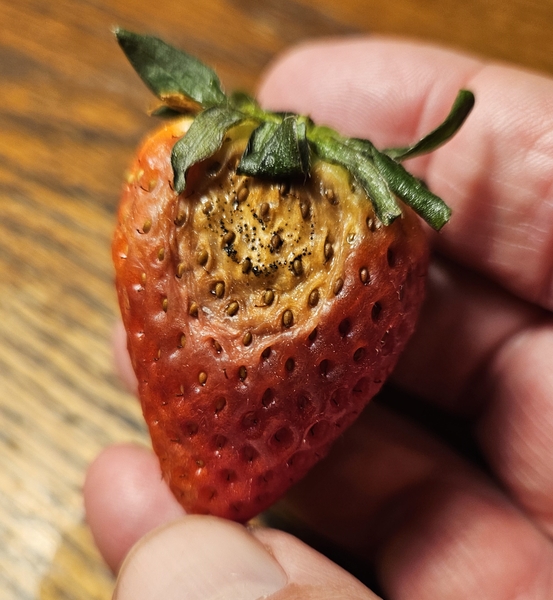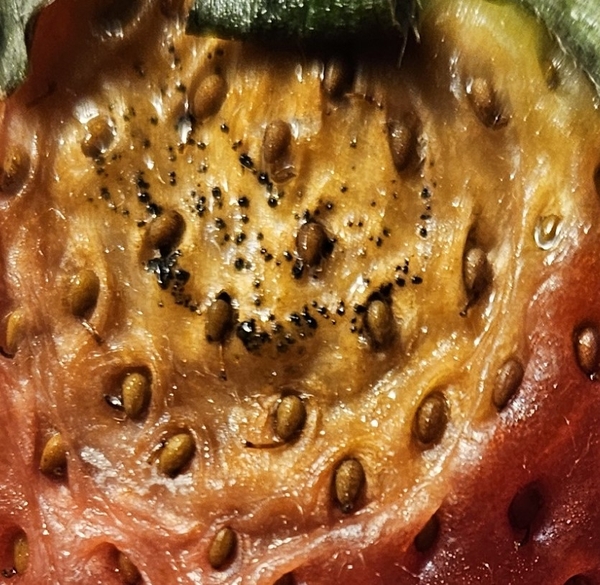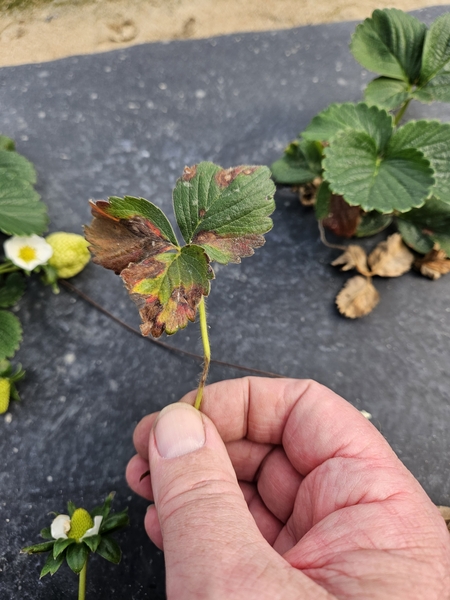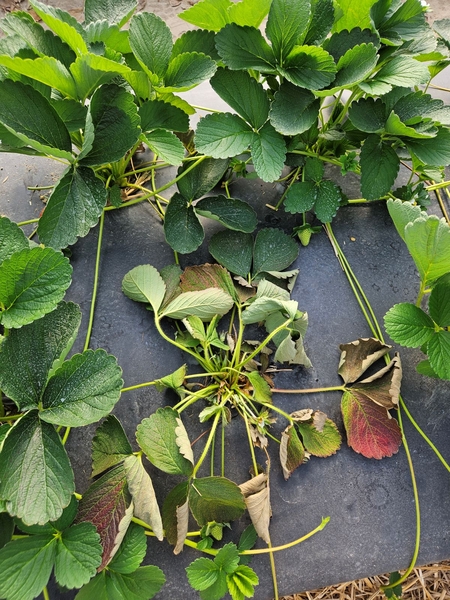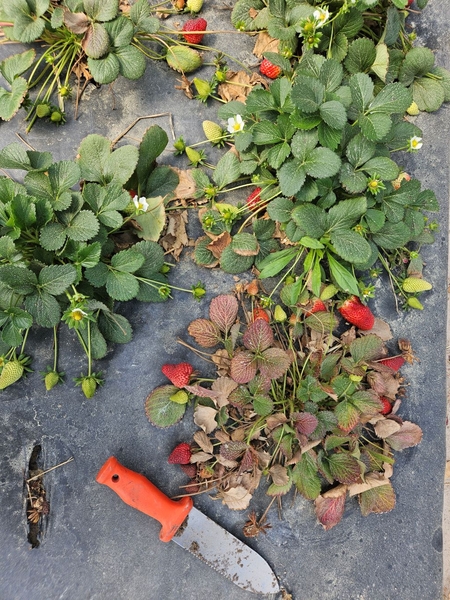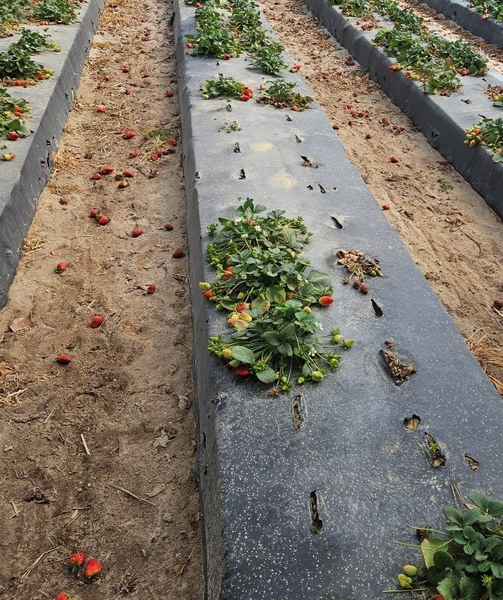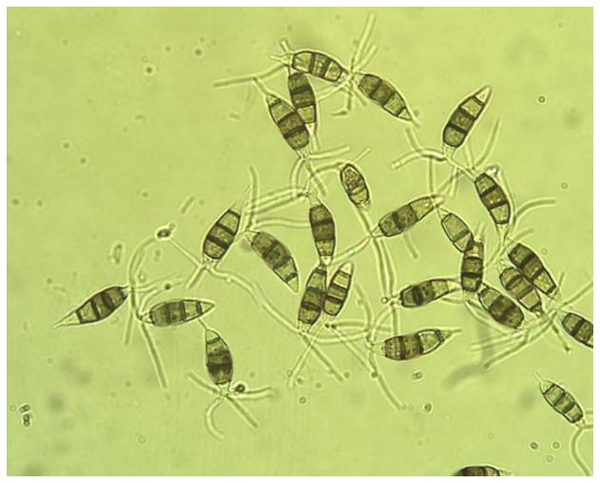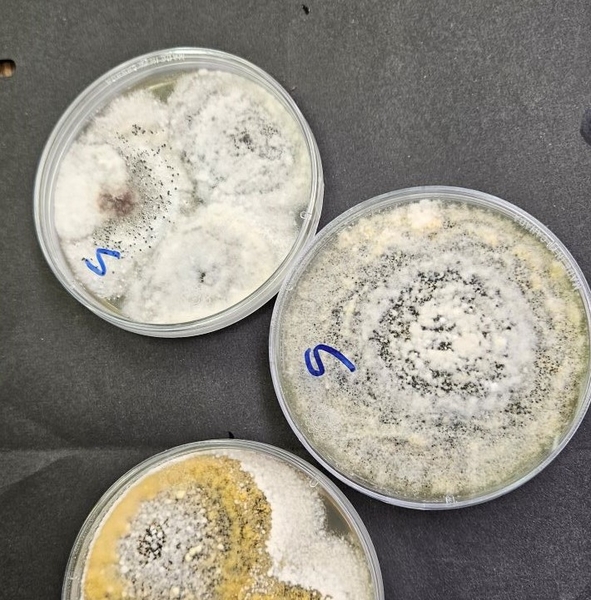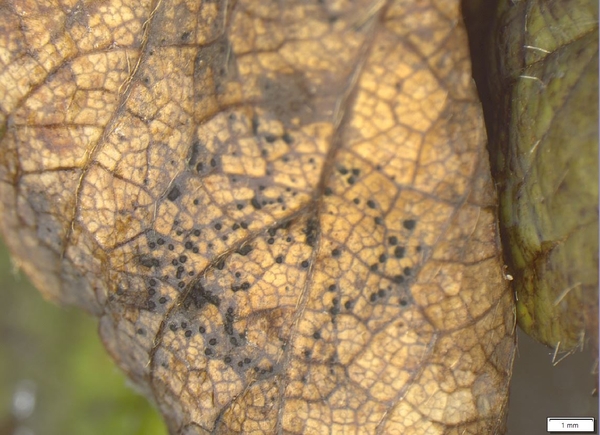Introduction
Neopestalotiopsis leaf, fruit, and crown rot is an important emerging fungal disease of strawberry that can affect every part of the plant (crown, roots, leaves, fruit). The symptoms were first widely known in the US on strawberry in 2018, following an outbreak in Florida in annual plasticulture fields. The disease was first confirmed in fruiting fields from North Carolina in 2022. The pathogen is most frequently introduced via infected planting stock. Pestalotia-like organisms are common as secondary infections, and prior to this outbreak, were considered to be only weakly pathogenic. The emergence of Neopestalotiopsis on strawberry, especially the aggressive forms of this pathogen, has resulted in significant crop loss throughout the southeastern US.
Symptoms and Signs
Leaf spots are often the earliest visible symptom of Neopestalotiopsis in newly-planted strawberry fields, and can occur in the fall and winter as plants are getting established. Leaf symptoms can resemble those caused by other pathogens such as Gnomonia leaf spot, Phomopsis leaf spot, or secondary organisms like Alternaria. Culturing or moist-chamber incubation followed by microscopic examination of spores is required for accurate diagnosis.
Crown infections cause wilting, stunting, and death of infected plants. Wilting can occur at any time in the growing cycle but is most severe when plants are producing fruit. Above-ground symptoms of crown rot include characteristic reddening of older leaves, while new emerging leaves may be stunted and mottled, followed by overall wilting and plant death. Early Neopestalotiopsis crown rot symptoms are difficult to distinguish from other crown rots (Phytophthora crown rot, anthracnose crown rot), therefore laboratory culturing or incubation is required for confirmation.
Fruit infection results in sunken, tan lesions with abundant black sporulation. Early symptoms resemble other fruit rots (Gnomonia, leather rot, Botrytis, anthracnose) but can be distinguished by the distinctive black spore masses on lesions, and further by microscopic identification of the distinctive spore morphology.
Overview of the Disease
The most likely means of introduction is on infected planting stock from plant nurseries. Infected plants often appear healthy at the time of planting. In annual plasticulture in North Carolina, planting of rooted tips (plug plants) occurs in late September or early October. Infected transplants may develop symptoms days or weeks after planting, and exhibit a range of symptoms -- the disease cycle is not well understood. In some cases leaf symptoms develop in the fall soon after planting, often on the leaves of the original transplant prior to development of any new leaves.
Wilting from crown infections can occur at any time but is most often observed when plants are in the fruiting stage. This can occur during winter in protected high tunnel production systems, or in the spring and summer in open-field fruit production. Neopestalotiopsis crown infections produce reddening of older leaves and stunting and yellowing of new growth, but cannot be distinguished from infections caused by other pathogens based on field symptoms alone. Isolation in sterile culture or moist-chamber incubation is recommended, followed by microscopic confirmation.
In-field spread is likely through rain-splashing and wind, and on contaminated hands, clothing and equipment, with infection occurring during periods of extended leaf wetness.
The fungus exists as a diverse population -- this is a newly-described, emerging pathogen, and isolates are grouped by researchers into "aggressive" and "non-aggressive" based on the severity (or absence) of symptoms. However, as a practical matter growers should consider any infection producing leaf, fruit or crown symptoms to be an aggressive isolate.
While infected planting stock is the most likely source of disease, the fungus can also persist in the soil on old infected crowns and strawberry plant debris, so it is possible for the pathogen to carry over from one year to the next in fields with a history of Neopestalotiopsis. It is not clear to what extent this "oversummering" contributes to disease in North Carolina -- infested fields have been observed to have little or no disease the following year when clean plants were used in the second year. The risk of carryover may be greater after severe outbreaks, or after multiple years without rotation.
Best Management Practices
The use of disease-free plants is the primary means of avoiding this disease. At this time there are no known resistant cultivars. The efficacy of dip treatments is not known. For fields with a prior history of strawberry production and especially where Neopestalotiopsis occurred in the previous year, bed fumigation is strongly encouraged. For fields that are fallow over summer between strawberry crops (June to September), repeated passes with a disc harrow can be used to break up crop debris. Bottom plowing (turn-plowing) can be used to further bury crop debris.
Once strawberries are planted, avoid handling plants when wet, and practice sanitation of worker's hands, clothing, boots and tools. To prevent the spread of disease, avoid moving from infected fields to clean fields during hand labor operations, such as when removing dead leaves or harvesting fruit. Work in problem fields last to minimize the risk of spreading spores to non-infested areas. Santitize equipment and if possible avoid sharing equipment between fields or between farms. It is not practical to remove infected leaves, but there may be some benefit to removal and destruction of symptomatic plants with crown wilt symptoms, both to reduce spore production and to limit spread of disease. Removing infected plants, including their crowns and roots, from the field helps reduce the amount of infected plant debris that could otherwise persist and serve as a potential source of infection in the following year. Fungicides known to have efficacy against Neopestalotiopsis (Thiram, Switch) can be incorporated into a weekly spray program during bloom and harvest. Apply fungicides in an alternating schedule to avoid relying on a single fungicide mode of action. It is currently not known whether any fungicide-resistant strains exist.
References
Brannen, P. 2024. Disease Update for Strawberries in Georgia. UGA Strawberry News, 20 April 2024.
Zuniga, A.I., Baggio, J.S. and Peres, N.A. 2024. A Semi-Selective Medium to Evaluate Over-Summering Survival of Neopestalotiopsis sp. in Florida Strawberry Fields. Plant Dis. 108: 2096-2013.
Baggio, J.S. and Peres, N.A. 2021 Neopestalotiopsis disease in strawberry: what do we know? Small Fruit News, Fall 2021. https://smallfruits.org/2021/10/neopestalotiopsis-disease-in-strawberry-what-do-we-know/
Publication date: April 12, 2024
Reviewed/Revised: Aug. 5, 2024
N.C. Cooperative Extension prohibits discrimination and harassment regardless of age, color, disability, family and marital status, gender identity, national origin, political beliefs, race, religion, sex (including pregnancy), sexual orientation and veteran status.

